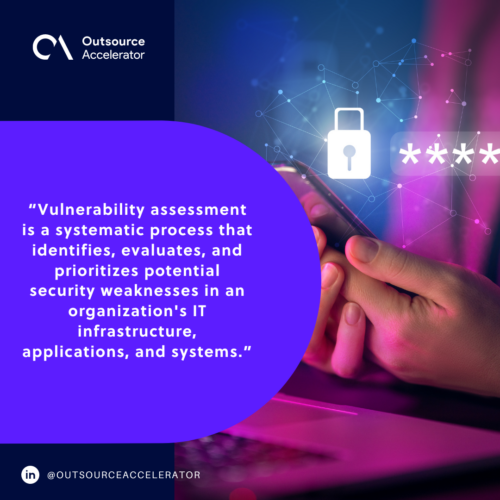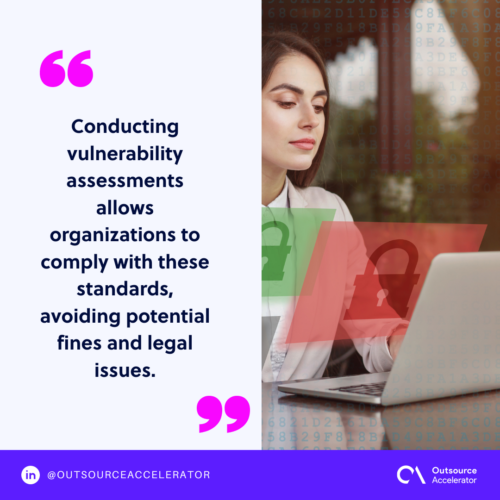Secure your IT infrastructure with vulnerability assessment services

Cybersecurity is a vital component for businesses aiming to protect their IT infrastructure from an ever-evolving array of threats.
The increasing reliance on technology and interconnected systems has forced organizations to prioritize safeguarding their sensitive data and maintaining operational integrity.
Effective cybersecurity measures not only prevent unauthorized access and data breaches but also build trust with clients and stakeholders.
In this article, we’ll highlight the significance of vulnerability assessment services. We’ll also showcase how third-party providers empower firms to fortify their organizational IT assets against potential risks and establish a resilient cybersecurity posture.
What is vulnerability assessment?
Vulnerability assessment is a systematic process that identifies, evaluates, and prioritizes potential security weaknesses in an organization’s IT infrastructure, applications, and systems.
The goal is to discover vulnerabilities that attackers could exploit and provide actionable recommendations for mitigating these risks. This assessment typically involves:
- Scanning for known vulnerabilities
- Analyzing security configurations
- Evaluating the effectiveness of existing security controls
It helps organizations strengthen their defenses and enhance their overall cybersecurity posture.
Premier cybersecurity and consulting providers offer businesses a comprehensive suite of security services that encompass all facets of their IT assets.
They help organizations build robust IT ecosystems where every component is armored to withstand potential cyber-attacks.
These IT solutions companies prioritize security at every level and empower businesses to operate confidently in an increasingly complex digital landscape.

How vulnerability assessment services work
A vulnerability assessment process is designed to provide an objective evaluation of corporate security.
Here’s how it works:
1. Investigate
The assessment begins with a thorough analysis of the systems to be tested.
Its team of cybersecurity specialists identifies each system’s role within the environment, key parameters, and necessary configurations to understand its security landscape.
2. Benchmark
Next, specialists examine the normal behavior of the tested systems and outlines expected responses to potential cyberattacks. Benchmarking helps establish a baseline for evaluating security performance.
3. Scan
Using compliance guidelines and the specific context of the customer’s business, the team configures and launches advanced vulnerability scanners.
This step aims to identify unpatched vulnerabilities that could be exploited by hackers.
4. Report
Finally, cybersecurity experts compile a detailed report outlining the discovered vulnerabilities and their potential impact on overall security.
The report provides actionable insights that help organizations address weaknesses and strengthen their defenses against cyber threats.
Benefits of conducting vulnerability assessment
Cyber threats are constantly evolving. A vulnerability assessment serves as a proactive approach that helps identify weaknesses before they can be exploited.
Here are some of the key benefits of vulnerability assessment services:
1. Early threat detection
By identifying vulnerabilities before they are exploited, organizations can take immediate action to remediate risks. It can significantly reduce the chances of a successful cyberattack.
2. Enhanced security posture
Conducting periodic vulnerability assessments aids organizations in upholding a robust security posture. It makes sure that systems and applications are updated and protected against the latest threats.
3. Compliance assurance
Many industries are governed by regulations that require regular security assessments.
Conducting vulnerability assessments allows organizations to comply with these standards, avoiding potential fines and legal issues.

4. Prioritized risk management
Vulnerability assessments provide insights into the severity of identified weaknesses. Businesses are able to prioritize their remediation efforts based on the potential impact on their operations.
5. Informed decision-making
Vulnerability assessment services help companies understand the specific vulnerabilities in their environment. This makes it easier to make informed decisions about security investments and resource allocation to strengthen defenses.
6. Improved incident response
Knowing existing vulnerabilities allows organizations to develop more effective incident response plans. This means they are better prepared to handle potential security breaches.
Choosing the right vulnerability assessment services provider
Selecting the right vulnerability assessment services provider can be daunting. Here are key factors businesses should consider when choosing a provider to enhance their cybersecurity posture:
Expertise and experience
Look for a provider with a proven track record in vulnerability assessments and a team of certified cybersecurity professionals.
Check their experience in your industry, as specific sectors may have unique compliance requirements and security challenges.
Customized solutions
Each business has distinct needs and risks. Choose a provider that offers tailored solutions rather than one-size-fits-all packages.
They should be willing to work closely with you to understand your environment and provide assessments that align with your specific vulnerabilities.
Methodologies and tools
Inquire about the methodologies and tools the provider uses for assessments.
Leading providers often employ a mix of automated tools and manual testing techniques to deliver thorough and accurate results.

Reporting and remediation support
Assess how the provider communicates findings. Look for detailed, actionable reports that prioritize vulnerabilities based on risk level.
Additionally, a good provider should offer remediation support or guidance to help you address identified vulnerabilities effectively.
Reputation and references
Research the provider’s reputation in the industry. Seek reviews, testimonials, and case studies from previous clients.
Request references to gain insights into the provider’s reliability and the quality of its services.
Compliance and certifications
Ensure that the provider adheres to relevant industry standards and possesses necessary certifications, such as ISO 27001 or PCI DSS.
Compliance with these standards indicates a commitment to quality and security best practices.
Ongoing support and services
Cybersecurity is an ongoing process. Choose a provider that offers continuous monitoring, periodic assessments, and updates to ensure your organization remains protected against evolving threats.
Cost and value
While cost is a significant factor, it’s essential to evaluate the value of the services provided. A cheaper option may not always be the best choice if it compromises the quality of the assessment.
By considering these factors, businesses can find a partner that not only identifies vulnerabilities but also helps implement effective strategies to mitigate risks.







 Independent
Independent




